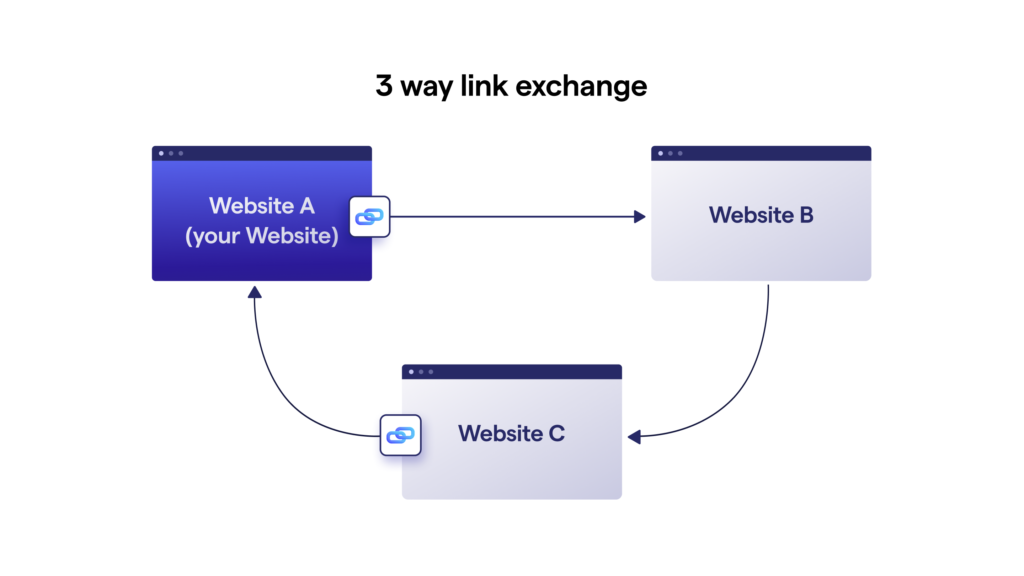
You know you need backlinks if you want to improve your search engine rankings. The problem is how to get them. 65% of digital marketers site link building as the most difficult part of SEO.
There are myriad strategies out there to help you build links. Reciprocal linking, or link exchanges, has long been a go-to strategy for link builders.
So, can a reciprocal link exchange still work in 2023?
In this article, we’ll examine the benefits, concerns, and risks of reciprocal links.
What is a link exchange?
A link exchange is when two websites agree to trade links to boost their rankings and authority. It’s something we can do here at Linkflow, and we’d love to work with you.
This type of agreement is also referred to as “reciprocal linking” or a “link swap.” Basically, two or more websites link to each other in order to boost their reputation.
It’s something that happens naturally, and often you’ll find that websites in the same niche link to each other because it makes sense to do so. You’ll even frequently find competitors linking to each other as they compare and contrast their product offerings.
However, sometimes websites make an actual plan to do this. That’s the type of link exchange we’ll be talking about.
How do Link Exchanges Work?
Link exchanges usually occur through cold email outreach, inside Facebook groups or Slack channels. Once initial contact has been made, both parties agree to swap links.
There are a few ways to go about exchanging links:
- 2-Way Link Exchange: A website owner agrees to link to another site, and the other site reciprocates by agreeing to link back.
- 3-Way Link Exchange: A webmaster contacts a third party to establish a triangular linking structure.
- Guest Post Swap: Two bloggers agree to post content on each other with links back to their own pages included in each.
Some practices are safer than others, but they all involve the same principle: linking to another page to improve your site’s ranking.
Why Would Someone Want to Exchange Links?
Links are essentially the currency of the internet—they establish trust and authority between websites. As such, a solid link profile is critical for SEO.
And since Google is the most visited website on the internet and the first three organic search results account for more than half of organic traffic, businesses with good SEO standing enjoy more viewers, leads, sales, and, ultimately, revenue.
But when every website competes for organic search traffic, the competition is fierce. There are countless keywords, product niches, and industries that have an extremely high amount of competition.
With the incentive to grow and monetize as quickly as possible, trading links with others who share the same goals seems like a cheat code.
Because it is a relatively easy way to earn links, it has remained one of the most interesting trends in SEO.
Are Reciprocal Link Exchanges Safe for Getting Backlinks?
According to Google Webmaster guidelines, a link exchange doesn’t violate their terms of service, until the reciprocal linking is considered “excessive.” Excessive link exchanges are considered a link scheme and can come with penalties.
The key word here is “excessive”. The reality is that reciprocal links naturally occur on the web almost everyday, which we’ll explain more later.
If you want to safely exchange links, here are some recommendations to follow:
Indirect Link Exchange

Go with an “indirect” link exchange. This is where you link out to another website using one page, and receive a link to your website via a completely different page. The other website links in and out in the same fashion so there are a total of four pages involved in the exchange.
Build Relationships
You should always analyze the website that you plan to reciprocally link to. Make sure you’ve assessed their traffic, the amount of backlinks they have, and other metrics we’ll get into further later on. You probably also want to review some of their content to make sure it’s up to your own standards and provides value.
Make sure you have open communication with the partner website throughout the process.
Mix it Up
Don’t rely on reciprocal links as your sole source of backlinks. That’s when you edge closer into link scheme territory. When it comes to backlinking, you want a diverse set of strategies to follow, instead of sticking to just one. A link building agency can help a lot to keep your profile diverse and combine different methods.
Know Your Limits
Companies like Dotdash Meridith have dominated Google Search results by using link exchanges internally with their massive portfolios.
Dotdash Meridith owns Investopedia, The Balance, The Spruce Eats, Verywell fit and many more brands that you’ve probably seen in tons of Google Searches.
Not just Dotdash Meredith but tons of other publicly traded digital companies are dominating search engines with reciprocal links and private link networks.
When you have a big link profile, there’s more leeway for link exchanges. However, they shouldn’t be your entire strategy and you should always make sure to diversify your profile with other types of links.
Following these best practices should keep you in line with Google’s Webmaster guidelines.
Reciprocal Linking Happens
Ahrefs did a study on reciprocal links back in 2020 that remains the most comprehensive resource today.
They found:
74% of websites have reciprocal links. It makes sense, but it’s nice to actually have the numbers to back it up. Far more sites are exchanging links than aren’t.
Interestingly, about a third of the sites they studied have at least a 15% overlap between the sites they link to and the sites that link to them. That’s a lot of reciprocal links.
On average, 4-5 out of every top 10 organic Google rankings have done a link exchange.
The Truth About Backlink Exchanges
Like we mentioned, backlink exchanges happen naturally across the web. But that’s where it gets tricky.
Picture two scenarios:
- Scenario 1: Website A loves the content on Website B, so it links to it in its new content. Website B also likes the content on Website A. Since they are in the same niche and Website B sees contextual relevance, it decides to link back. Aside from this, no relationship exists between the two web pages.
- Scenario 2: Website A and Website B are in the same niche. They both want to improve their link profiles, so they decide to work together and arrange a reciprocal link exchange agreement.
Scenario 1 happens all the time. When two web pages share relevant and valuable information on a topic, the idea that they would link to one another isn’t far-fetched.
An Ahrefs study even found that 73.6% of sites have reciprocal links.
Scenario 2 is a clear violation of Google’s Webmaster Guidelines, which reference “link to me and I’ll link to you” and partner pages exclusively for the sake of cross-linking.”
The main difference here is the intent but can Google tell the difference?
As long as there are no alarming footprints or evidence that this has been done between the two sites in excess, then the answer is most likely no.
3-Way Link Exchanges

A 3-way link exchange is a type of link building technique that involves three websites instead of just two. This type of agreement provides more power to site owners, as it allows them to benefit from mutual link exchanges without having to depend on one another.
Essentially, each website involved in a 3-way link exchange will link to one another.
The main benefit of a 3-way link exchange is that it allows each of the three websites to benefit from increased link authority without having to depend directly on each other.
Since it removes the evidence of one website linking to another and makes it seem more natural, it also gives site owners more flexibility in the types of content they link to. Generally speaking, search engines can’t see 3-way link exchanges as easily as they can with a typical reciprocal link exchange.
Guest Post Swaps
Guest post swaps are another great way to build relationships with other websites and benefit from increased link authority.
Essentially, two websites will agree to swap content by having each other’s writers contribute articles to their respective sites. This way, both websites can get fresh and valuable content for their readers while increasing the quantity of inbound links pointing back to their site.
Guest post swaps are another way to boost your SEO value without coming off as spammy. But it’s important to remember that content quality always comes first.
If your guest post author isn’t writing high-quality content for your site, it will reflect poorly on your brand. And if your product, service, or site content has no relevancy on the placement site, there’s no point in doing a guest post swap in the first place.
Are Link Swaps Good For SEO Rankings?
Link swaps can be good for SEO. Getting backlinks is usually a process that takes time and effort, so link swaps can be an effective shortcut. Reciprocal link building can sometimes double or triple the number of backlinks you have in a short amount of time.
But not all links are created equal. In order to ensure you’re getting quality backlinks from your link swaps, follow these best practices:
- Vet your placement sites for quality and relevancy. Look at all of their content, each site metric (e..g, user engagement, DA, etc.), and their link profiles before agreeing to anything.
- Make sure you’re offering quality content in return. If you’re participating in guest post swaps, make sure that the content you offer is of good quality and topical relevance.
- Focus on building relationships with other websites. Don’t just focus on the links you get out of the swap—focus on developing a real connection.
- Make sure that the exchange is beneficial to both parties. Quality backlinks should be offered in exchange for quality content or services, not just to help you with link building.
- Avoid swapping links with sites that are direct competitors. If both sites compete for the same keywords, it won’t make sense to link to each other.
- Be strategic in your outreach. Simply asking for links probably won’t get you far. But if you have something valuable to offer in return, you’ll be more likely to find link exchange opportunities.
What to Look for When Considering a Link Exchange
If you want to maximize the amount of link juice you get from a link swap, you’ll need to pay attention to the following criteria:
- Relevance and Authority: Ensure the sites you swap backlinks with are relevant to your niche and have good domain authority. If you aren’t linking with related sites, they might not be providing much value.
- Anchor Text: Pay attention to the anchor text you use for your backlinks. Others will need to read the content, so your link should make grammatical and logical sense in the body text.
- Dofollow/Nofollow Links: Dofollow links pass link juice and are important for SEO, while no-follow links don’t. Make sure that you’re exchanging dofollow links with quality sites in order to get the most out of your reciprocal links. However, some quality sites might use nofollow links, so it’s important to check before agreeing to an exchange.
- Content Quality: Before deciding to exchange links with another website, conduct quality checks that examine the content of the linked page. If it’s low-quality, chances are it won’t provide much SEO value.
- Link Placement: Some outbound links are placed in a header, footer, or sidebar. While these may still provide some SEO benefit, they won’t be as valuable as contextual links placed within content.
Questions to Ask About Reciprocal Links
Make sure you take your time when deciding whether or not you want to do a link exchange with a potential partner website. Exchanging links can be tricky to get right the first few times.
Where will your backlink go on the other website?
Your goal is to ensure your link will be placed on a contextually relevant page. Avoid placements in the footer or sidebar.
What other websites will the referring page link out to?
In theory, you want to work with partners that are using reciprocal linking sparingly. Check on the amount of external links they typically have in their content and review some of their inbound links.
You’ll have an idea of whether this is a good potential partner and how much weight their link might carry. You’re also trying to avoid working with someone that makes excessive link exchanges.
What is the purpose of the website you’re working with?
When you can, try to find websites that serve a similar purpose as yours. You want the links to make sense and potentially provide value to readers. You should also try to make sure the site isn’t just out to make a quick buck or exist for some nefarious purpose.
Where to Find Link Exchanges
If you want to use reciprocal links as a part of your online marketing strategy, there are several places you can find them.
Private link building groups (i.e., communication channels where everyone conducts outreach and link swaps) are a great place to start. As you employ other link building tactics like guest posting, content marketing, and broken link building, you’ll naturally find potential link partners in your industry.
There are a few ways to find these communities. Slack channels and Facebook groups for reciprocal linking have become fairly common. This makes it easier to find contextually relevant websites to pair up with. The more natural it feels to link between websites, the less risk you take.
You can also build an influencer network of your own by reaching out to partners and influencers in your industry. Ask them if they’re interested in exchanging links, or if they have any recommendations for other sites where you can do so.
In any case, the most essential thing to remember is that link exchanges should be mutually beneficial. Don’t bother participating in an exchange unless it will provide real value to both parties (and the people who inevitably land on your content).

Brittney Fred, SEO Analyst
Brittney has been working in SEO and digital marketing for ten years and specializes in content strategy for the B2B SaaS industry. She is based in Denver, CO and absolutely fits the Denverite stereotype. You’re just as likely to find her hiking, snowboarding, or doing yoga as reading sci-fi or playing video games.
